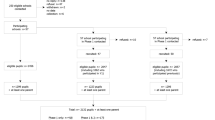Abstract
Objective:
The purpose of this study was to examine the utility of pedometer-based physical activity recommendations in predicting childhood adiposity.
Design:
Subjects (n=608) (9.6 years) were from two Midwestern USA communities. Physical activity was assessed by a pedometer. The percentage of subjects meeting physical activity recommendations was determined using published recommendations. Overweight and obesity were determined based on reference values for the body mass index (BMI) developed by the International Obesity Task Force. An elevated waist circumference (WC) was determined based on age- and sex-specific reference values >75th percentile.
Results:
Children who did not meet the pedometer recommendations were about two times more likely to be overweight/obese and have an elevated WC compared with those meeting recommendations. The BMI and WC were significantly different across pedometer step count groups in males and females.
Conclusion:
Subjects not meeting the recommendations for steps per day were more likely to be classified with the overweight phenotype than those meeting the recommendation. A dose–response relationship between pedometer steps per day and adiposity is also apparent.
This is a preview of subscription content, access via your institution
Access options
Subscribe to this journal
Receive 12 print issues and online access
$259.00 per year
only $21.58 per issue
Buy this article
- Purchase on Springer Link
- Instant access to full article PDF
Prices may be subject to local taxes which are calculated during checkout
Similar content being viewed by others
References
Tudor-Locke C, Bassett D . How many steps/day are enough? Preliminary pedometer indices for public health. Sports Med 2004; 34: 1–8.
Vincent SD, Pangrazi RP . An examination of the activity patterns of elementary school children. Pediatr Exerc Sci 2002; 14: 432–441.
Tudor-Locke C, Pangrazi RP, Corbin CB, Rutherford WJ, Vincent SD, Raustorp A et al. BMI-referenced standards for recommended pedometer-determined steps/day in children. Prev Med 2004; 38: 857–864.
Twisk JW . Physical activity guidelines for children and adolescents: a critical review. Sports Med 2001; 31: 617–627.
Cole TJ, Bellizzi MC, Flegal KM, Dietz WH . Establishing a standard definition for child overweight and obesity worldwide: international survey. BMJ 2000; 320: 1240–1243.
Fernandez JR, Redden DT, Pietrobelli A, Allison DB . Waist circumference percentiles in nationally representative samples of African-American, European-American, and Mexican-American children and adolescents. J Pediatr 2004; 145: 439–444.
Goran MI . Energy expenditure, body composition, and disease risk in children and adolescents. Proc Nutr Soc 1997; 56: 195–209.
Casperson CJ, Nixon PA, DuRant RH . Physical activity epidemiology applied to children and adolescents. Exerc Sci Sports Rev 1998; 26: 341–403.
Eisenmann JC . Physical activity and cardiovascular disease risk factors in children and adolescents: an overview. Can J Cardiol 2004; 20 (3): 295–301.
Patrick K, Norman GJ, Calfas KJ, Sallis JF, Zabinski MF, Rupp J et al. Diet, physical activity, and sedentary behaviors as risk factors for overweight in adolescence. Arch Pediatr Adolesc Med 2004; 158: 385–390.
Anderson RE, Crespo CJ, Bartlett SJ, Cheskin LJ, Pratt M . Relationship of physical activity and television watching with body weight and level of fatness among children: results from the Third National Health and Nutrition Examination Survey. JAMA 1998; 279 (12): 938–942.
Dowda M, Ainsworth BE, Addy CL, Saunders R, Riner W . Environmental influences, physical activity, and weight status in 8- to 16-year-olds. Arch Pediatr Adolesc Med 2001; 155: 711–717.
Eisenmann JC, Bartee RT, Wang MQ . Physical activity, television viewing and weight status in U.S. adolescents: results from the 1999 YRBS. Obes Res 2002; 10: 379–385.
Janssen I, Katzmarzyk PT, Boyce WF, Vereecken C, Mulvihill C, Roberts C et al., Health Behaviour in School-aged Children Obesity Working Group. Comparison of overweight and obesity prevalence in school-aged youth from 34 countries and their relationships with physical activity and dietary patterns. Obes Rev 2005; 6: 123–132.
Haskell WL . Health consequences of physical activity: understanding and challenges regarding dose–response. Med Sci Sports Exerc 1994; 26 (6): 649–660.
Vincent S, Pangrazi R, Raustorp A, Tomson L, Cuddihy T . Activity levels and body mass index of children in the United States, Sweden, and Australia. Med Sci Sports Exerc 2003; 35: 1367–1373.
Sims EA, Danforth EJ, Horton ES, Glennon JA, Bray GA, Salans LB . Experimental obesity in man. A progress report. Isr J Med Sci 1972; 8: 813–814.
Thorburn AW, Proietto J . Biological determinants of spontaneous physical activity. Obes Rev 2000; 1: 87–94.
Acknowledgements
In Lakeville, Minnesota SWITCH is sponsored by Medica Foundation, Healthy and Active America Foundation, and Fairview Health Services. In Cedar Rapids, Iowa SWITCH is sponsored by Cargill and the Healthy and Active America Foundation. SWITCH is a trademark of the National Institute of Media and the Family MediaWise campaign.
Author information
Authors and Affiliations
Corresponding author
Rights and permissions
About this article
Cite this article
Eisenmann, J., Laurson, K., Wickel, E. et al. Utility of pedometer step recommendations for predicting overweight in children. Int J Obes 31, 1179–1182 (2007). https://doi.org/10.1038/sj.ijo.0803553
Received:
Revised:
Accepted:
Published:
Issue Date:
DOI: https://doi.org/10.1038/sj.ijo.0803553
Keywords
This article is cited by
-
Influence of the relative age effect on children’s scores obtained from the Canadian assessment of physical literacy
BMC Public Health (2018)
-
The relationship between physical literacy scores and adherence to Canadian physical activity and sedentary behaviour guidelines
BMC Public Health (2018)
-
Social and Environmental Determinants of Child Physical Activity in a Rural Mexican-Origin Community
Journal of Community Health (2016)
-
The Canadian Assessment of Physical Literacy: methods for children in grades 4 to 6 (8 to 12 years)
BMC Public Health (2015)
-
A cross-sectional study of the individual, social, and built environmental correlates of pedometer-based physical activity among elementary school children
International Journal of Behavioral Nutrition and Physical Activity (2011)


